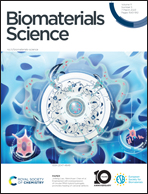Nano-encapsulation of halofuginone hydrobromide enhances anticoccidial activity against Eimeria tenella in chickens†
Abstract
Coccidiosis is a worldwide epidemic intestinal disease with high incidence, which causes huge economic losses. Halofuginone hydrobromide (HF) is widely applied as an effective anticoccidial drug in the poultry industry. However, its therapeutic efficacy is severely restrained due to toxic effects, poor aqueous solubility and low permeability. Nanotechnology can improve the biological effect of drugs, and thus, reduce administered doses and toxic effects. The objective of this study was to investigate the therapeutic and preventive potential of novel HF-loaded D-α-tocopherol polyethylene glycol 1000 succinate (TPGS) polymer micelles (HTPM) for preventing coccidiosis in chickens. The HTPM were approximately spherical with a hydrodynamic diameter of 12.65 ± 0.089 nm, a zeta potential of 8.03 ± 0.242 mV, a drug loading of 14.04 ± 0.12%, and an encapsulation efficiency of 71.1 ± 4.15%. HF was encapsulated in the polymer micelles through interactions with TPGS, as characterized by X-ray diffraction (XRD) and Fourier transform infrared (FT-IR) spectroscopy. Cellular take up assays showed that TPGS polymer micelles could enhance drug internalization to alleviate intestinal apoptosis induced by coccidiosis and promote the necrosis of second-generation merozoites of E. tenella. Notably, clinical trials proved that 1.5 mg L−1 HTPM had a stronger anticoccidial effect on E. tenella than that of 3 mg kg−1 HF premix. Amplicon sequencing identified that HTPM could alleviate coccidiosis by restoring the structure of the gut microbiome. These findings indicated that the anticoccidial efficacy of HF was significantly enhanced after being encapsulated in polymer micelles, and further demonstrated the potential protective application of nano-encapsulating anticoccidial drugs as a promising approach to control coccidiosis in poultry. In summary, HTPM hold huge potential as an effective therapeutic agent for coccidiosis.



 Please wait while we load your content...
Please wait while we load your content...